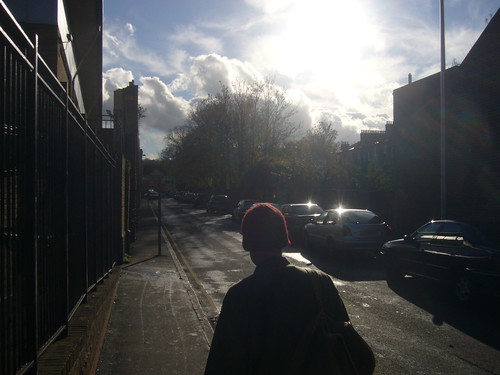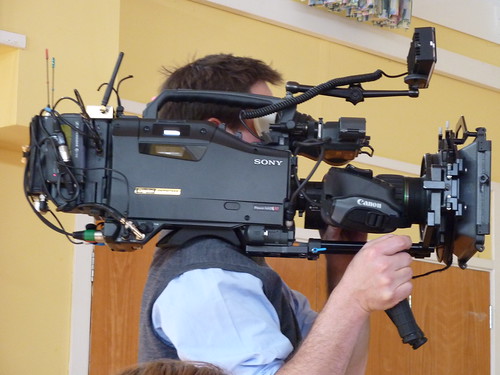If I were running an educational technology/ICT course now, I’d make taking and sharing at least one photo a week a requirement for remaining on the course. If booting someone off the course was not an option, I’d tie in a significant proportion of the marks to those activities. All this is impractical, of course. Even if I were allowed to get away with such draconian actions, I wouldn’t want to penalise a brilliant student for not taking a few snaps now and again. But think of the benefits to everyone if digital photography were a key component of a course – any course.
Developing good journalistic practice
 Now ANYONE can be a "press" photographer!
Now ANYONE can be a "press" photographer!
Many courses require students to report on their work in some way. There is plenty of research which indicates that illustrations are essential to boosting the chances of an article being read, especially if it has a caption. Apparently, that is what many readers look at first, suggesting that the photo and caption draw attract them in the first place. Schools are often described as being in a bubble, not part of the so-called '”real world”. Well, here’s a way to ensure that at least some of what goes on “out there” happens in the classroom too.
Build your own bank
Finding the right photo for an article is hard enough. Finding one that you can legally use is an extra, though by no means insurmountable, challenge (I find the Creative Commons search engine to be very good). But you’re unlikely to find a collection of photos taken in and around your own school. If you have 4 classes of 30 students each, whom you see each week for 40 weeks, and you asked each student to take and upload one photo a week, by the end of the first year you could have as many as 4 x 30 x 40 pics – that’s 4,800 in total!
Learning important things from the process
Apart from possibly developing their photographic skills, this ongoing activity would – or should – entail other learning as well. How to name, tag and describe photos would come into it for a start. Another issue to discuss would be data protection: are you legally allowed to take photos of people without their permission? I live in England, and the advice I read a few years ago (I haven’t checked to see if it has been updated recently) is that you can do so as long as the people are part of the scene in some way. For example, if you take a photo in a busy London street, you’re not expected, as far as I know, to try and grab everyone there and get them to sign a photo release form. The situation is different if you’re taking photos of a particular person, or at an event, like a conference (in which case the organisers would typically have included a blanket default permission as part of the terms and conditions of attending the conference).
But there are also ethical, common sense and privacy issues as well. For instance, I wouldn’t take photos of children I don’t know, for obvious reasons.
Finally, if I do take a photo of one person in particular, perhaps because what they’re doing makes for an interesting and potentially useful photo, I usually try to disguise their features in some way, like in the photo below:
Seeing things differently
I think taking photos, or even thinking about taking a photo, makes you see things differently. Certainly in my own case I tend to notice little things more if I am considering whether it would make a good or useful photo. An obvious application of this, which the Art advisor in an East London local authority once set his students, is to take photos of as many patterns as you come across in the next 15 minutes. We see patterns every day, and probably don’t really see them: brickwork, paving stones, shadows cast by TV aerials. Being assigned to take pictures of them certainly helps to sharpen your perception.
Sometimes, you can use photos to capture a mood or atmosphere, such as in this picture:
 After the rain in Lewisham, south London
After the rain in Lewisham, south London
Other times, use your camera as an aide-memoir, or to capture a (humorous?) sign.
Useful vs good
In the foregoing paragraph I deliberately drew a distinction between whether a photo is good or useful. I doubt whether many of my own photos will become the centrepiece of an exhibition, but they’re all (potentially) useful. Unless you’re running a photography course, there’s no need to insist on anything much beyond some basic good advice in my opinion, like the law of thirds. Most cameras will take a pretty good photo without any need for the user to adjust any settings at all.
Using the photos
Photos can be used as creative writing prompts, to illustrate a point, as the basis of a test question or essay or even simply for the pleasure of looking at something nice, interesting or both.
For more ideas on using digital photography, see the articles collated under the tag “digital photography” on the ICT in Education website.
Access to equipment
 You don't need this level of sophistication!
You don't need this level of sophistication!
You can buy a digital camera these days for under £40 ($63), so it should be possible to buy at least one class set that people can borrow.. Most students have phones, and most phones have cameras. From that point of view alone, Bring Your Own Technology seems to me an idea worth seriously considering. Transferring photos from camera to computer, or direct to the web, is a pretty simple process too. Thus, the final reason for using digital photography in your course is that it is, generally speaking, easy and inexpensive to do so.


